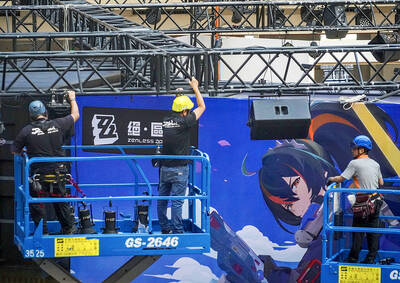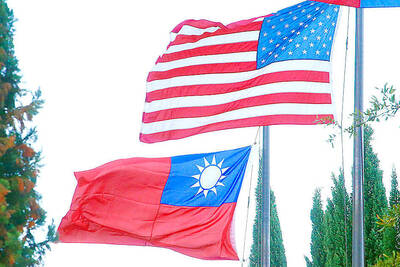With legislators and civic groups expressing their concern over the safety of nuclear waste treatment, Vice Minister of Economic Affairs Woody Duh (杜紫軍) said at the Legislative Yuan in Taipei yesterday that the ministry is planning to set up an independent nuclear waste treatment center.
At a meeting of the legislature’s Social Welfare and Environmental Hygiene Committee, legislators across party lines asked how the ministry, Taiwan Power Co (Tai-power, 台電) and the Atomic Energy Council (AEC) plan to deal with nuclear waste and whether they can ensure safety.
AEC Deputy Minister Chou Yuan-ching (周源卿) said 16,671 spent fuel bundles — high-level radioactive waste — produced by the three operating nuclear power plants are being kept in the plants’ spent fuel pools.
Duh said that because the pools at the first and second nuclear power plants in New Taipei City’s Jinshan (金山) and Wanli (萬里) districts are unable to store all the spent fuel bundles produced in the plants’ lifespan of 40 years, the bundles are to be moved to dry cask storage facilities that are now being built as midterm storage sites.
According to Taipower’s Spent Nuclear Fuel Final Disposal Program Plan, which is now evaluating potential rock formations, the final disposal site is to be decided by 2038 and ready to use by 2055, he said.
As for low-level radioactive waste disposal facilities, Chou said an estimated total number of about 740,000 barrels — including 292,048 barrels produced during their 40-year lifespan and 455,783 barrels produced during the decommissioning process — are to be created by the three nuclear power plants.
Duh said that about 100,000 barrels are stored on Lanyu (蘭嶼, Orchid Island) and others are being kept in storage facilities at the three power plants.
He added that the ministry in 2012 named Taitung County’s Tajen Township (達仁鄉) and Kinmen’s Wuchiu Township (烏坵鄉) as potential sites for building a final depository, but the two local governments have not agreed to hold local referendums to decide the site.
According to Yilan Charlei Chen Foundation president Chen Hsi-nan (陳錫南), who was invited to present to the committee, the design of Taiwan’s dry cask storage does not allow spent fuel bundles to be removed or transported to other sites, because it lacks sufficient vibration-proof and crash-proof material.
The oldest dry cask storage facilities in the US have only been used for 26 years, so Taipower cannot prove that the facilities can keep the spent fuel safe from leakage for 40 years, Chen added.
Meanwhile, He Li-wei (賀立維), a nuclear expert who worked at the Institute of Nuclear Energy Research, said seven hydrogen explosions occurred when the institute tried to remove fuel bundles from pools 26 years ago in Taoyuan County’s Longtan Township (龍潭).
Taipower vice president Chen Pu-tsan (陳布燦) said that although the oldest dry cast storage facilities in the US are just 26 years old, they were designed to be used for more than 40 years, and so are the ones designed for Taiwan.
Duh said three months ago, the ministry decided to establish an independent administrative institution to deal with nuclear waste issues, and public hearings are being held to collect opinions.

Taiwan is projected to lose a working-age population of about 6.67 million people in two waves of retirement in the coming years, as the nation confronts accelerating demographic decline and a shortage of younger workers to take their place, the Ministry of the Interior said. Taiwan experienced its largest baby boom between 1958 and 1966, when the population grew by 3.78 million, followed by a second surge of 2.89 million between 1976 and 1982, ministry data showed. In 2023, the first of those baby boom generations — those born in the late 1950s and early 1960s — began to enter retirement, triggering

ECONOMIC BOOST: Should the more than 23 million people eligible for the NT$10,000 handouts spend them the same way as in 2023, GDP could rise 0.5 percent, an official said Universal cash handouts of NT$10,000 (US$330) are to be disbursed late next month at the earliest — including to permanent residents and foreign residents married to Taiwanese — pending legislative approval, the Ministry of Finance said yesterday. The Executive Yuan yesterday approved the Special Act for Strengthening Economic, Social and National Security Resilience in Response to International Circumstances (因應國際情勢強化經濟社會及民生國安韌性特別條例). The NT$550 billion special budget includes NT$236 billion for the cash handouts, plus an additional NT$20 billion set aside as reserve funds, expected to be used to support industries. Handouts might begin one month after the bill is promulgated and would be completed within

NO CHANGE: The TRA makes clear that the US does not consider the status of Taiwan to have been determined by WWII-era documents, a former AIT deputy director said The American Institute in Taiwan’s (AIT) comments that World War-II era documents do not determine Taiwan’s political status accurately conveyed the US’ stance, the US Department of State said. An AIT spokesperson on Saturday said that a Chinese official mischaracterized World War II-era documents as stating that Taiwan was ceded to the China. The remarks from the US’ de facto embassy in Taiwan drew criticism from the Ma Ying-jeou Foundation, whose director said the comments put Taiwan in danger. The Chinese-language United Daily News yesterday reported that a US State Department spokesperson confirmed the AIT’s position. They added that the US would continue to

IMPORTANT BACKER: China seeks to expel US influence from the Indo-Pacific region and supplant Washington as the global leader, MAC Minister Chiu Chui-cheng said China is preparing for war to seize Taiwan, Mainland Affairs Council (MAC) Minister Chiu Chui-cheng (邱垂正) said in Washington on Friday, warning that Taiwan’s fall would trigger a regional “domino effect” endangering US security. In a speech titled “Maintaining the Peaceful and Stable Status Quo Across the Taiwan Strait is in Line with the Shared Interests of Taiwan and the United States,” Chiu said Taiwan’s strategic importance is “closely tied” to US interests. Geopolitically, Taiwan sits in a “core position” in the first island chain — an arc stretching from Japan, through Taiwan and the Philippines, to Borneo, which is shared by